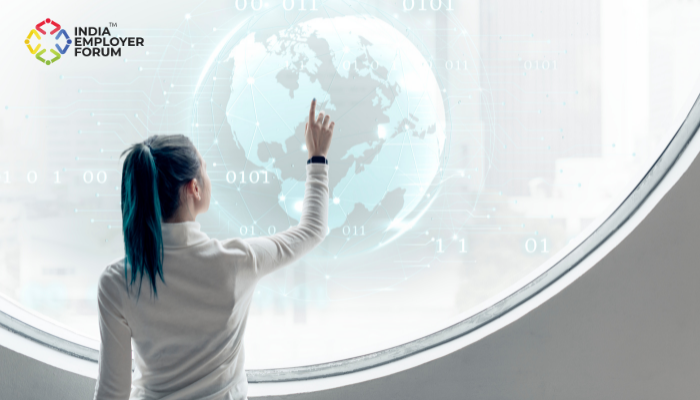Automating repeatable tasks via robotic co-workers can offer big savings in a variety of resources spent at a job. For nearly a decade, the tech and functionality of robotic co-workers were challenging in terms of implementation. But in this latest age of Artificial Intelligence (AI), the big picture is clearer. In terms of savings in performance and ease of doing tasks, the trade-off is stacked clearly in favor of the initial cost of introducing robotic co-workers.
What makes the times just right for robotic co-workers
In the world of work, it is very common, even desirable, to have tasks that are repeated daily, weekly, monthly, and so forth. Robots at workplaces would not only keep timely reminders and updates on these tasks logged for their human counterparts but can also go so far as to finish a portion of the task as per a set of instructions.
You might also be interested to read: In Demand Skills In India
This is an excellent time to introduce a workforce of collaborative robots so that human resources are deployed towards the jobs they are most adept at – judgment, evaluation, and decision-making at the very highest levels of business aptitude. As such, grassroots-level tasks in the world of work that are rote and repeatable can be allocated to the programmable and highly customizable digital workforce. The reasons robotic co-workers are eminently suitable to human robot-collaboration are:
- They are highly accurate and precise
- They can be upgraded or reprogrammed as needed
- Their high-power computing, sharing, and comprehension abilities make them valuable while handling large sets of data and processing requirements
The age of AI has made human-computer interaction possible, even if the end-users themselves do not possess superior technical abilities. The whole point of machine learning algorithms which currently find many applications in the industry is that human-machine collaboration is possible without the need for the average professional to take up sophisticated learning which can take a lot of time to bring to fruition. Due to the success of natural language processing and artificial intelligence applications, the collaboration between humans and machines has hit a whole new level of progress.
Digital transformation makes relatable results possible for business concerns
For business owners and industry leaders, it is an exciting time. Robots have been in the genesis stage for a long time now. They were expected to leave the laboratories and simplify certain sets of tasks in the last couple of decades. When robotic co-workers are used to enhance productivity metrics, they offer better returns on investment. In short, they make possible gains that were only envisaged in the distant future of work.
Accenture research claims that the collaborative robots, or ‘cobots’ as they are informally referred to, stand to account for 38% of a company’s revenue by the year 2022 if deployed in cohesion with their human workers. Difficulty levels of tasks are evaluated by humans and the ways around these tasks can be determined by experimentation. For instance, sensors are mounted on robotic workers so that they can detect obstacles. Then, the robotic co-workers can take up tasks that do not require human intelligence – such as gluing and welding in an industrial setting, picking up objects, transporting them, and placing them where required in packaging units, or coordinating assemblies. Potentially dangerous tasks in mining, excavation, and guided vehicles for exploration in inaccessible areas like an ocean floor can be coordinated with the help of cobots and robotic co-workers. These are areas in which a significant amount of task regrouping and allocation – 30% to 39% – can be expected to be offloaded to robots.
The way forward – opportunities and threats
The heartening news is that autonomous guided vehicles are already in use in nearly 50% of the applications. While this use is set to decline, according to the Accenture Connected Industrial Workforce report, other applications such as unmanned aerial vehicles, augmented reality devices, and collaborative robots are likely to see a spate of investment by the year 2022.
Digital transformation leaders are at the helm of creating this change in workplaces. They can point out the merits of programmability and precision which is a stressor for a human worker but a matter of straight-forward execution for a robotic co-worker. As greater memory, processing power, and an intuitive sense take shape within robotic workers, it is true that some human job roles may be supplanted with robots. But from a business sense, this is good news because skill shortages can be plugged through robots and guided AI. The managerial cadre continues to take complete digital transformation with caution. In a situation that calls for an evaluation of threats, system vulnerability, and data security decisions to be taken, it is best that the final say still remains largely within human managers’ purview.
A digital workforce acquires success by retaining control within human purview while reducing the burdens associated with a set of tasks. While the digital transformation is prepared to make this happen, an eye on rooting out loopholes and vulnerabilities is necessary. Such efforts are ongoing and the route to workable, sustainable solutions is still in the works.
Clear wins that set apart robotic co-workers
Workflows that save anything from a few seconds to several minutes are possible with robotic co-workers. The saving on human effort in carrying, packaging, and shipping is one aspect of why collaboration between humans and machines is sought after. Even more significant is the contrast with the human propensity for error. Robots do not have the off-chance of missing out on rules or committing parallax errors. Finally, the burnout faced by robotic workers is far more manageable than the mental health considerations that the leader of a human team has to take into account.
The speed with which robotic workers move, their paths, and the amount of workspace they need can be largely restricted – a model that is not workable with human workers. Planning them ahead of time is possible in a way it is not possible with a human workforce. Industrial precision, sterile conditions, refinement of performance, and productivity are the most obvious advantages for which robotic co-workers can soon become part of production floors.
References:
- Robotic Co-Workers: The Next Generation Of Robots At Workspaces | AnalyticsInsight.net | Vivek Kumar | September 2020
- Robots In The Wild – Viewing robots through a mission lens | Accenture Federal Services | Jayson Layman | September 2020
- Machine Dreams – Making the most of the Connected Industrial Workforce | Accenture Connected Industrial Workforce Research | January 2016
You might also be interested to read:
Related Topics:




